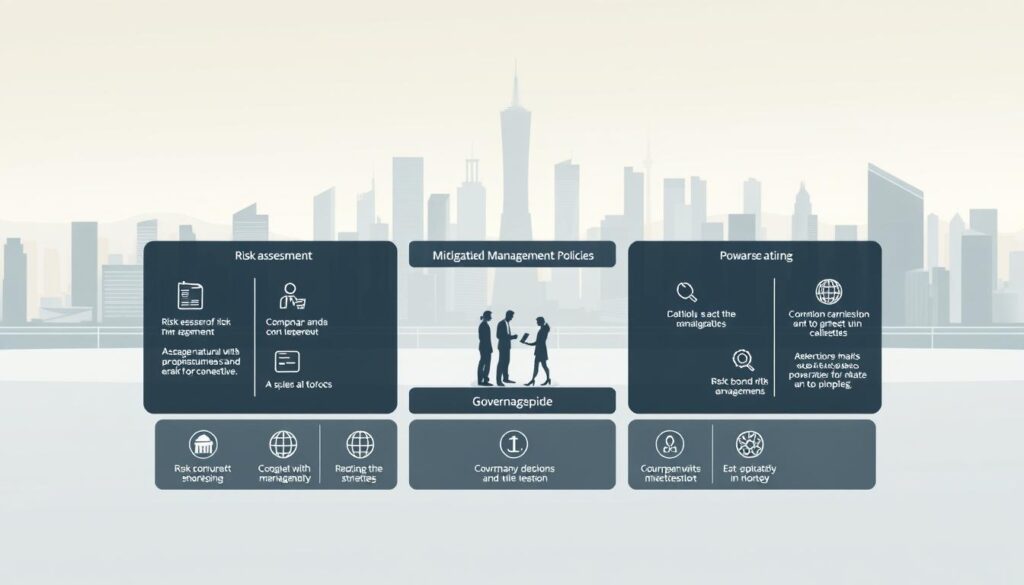What if the very technology driving modern innovation could become its greatest liability? As artificial intelligence reshapes industries, a stark paradox emerges: 72% of companies now deploy these systems, yet 96% of executives admit generative tools heighten breach risks. Only 24% of projects, however, implement adequate safeguards. This disconnect reveals a critical truth—speed often eclipses security in today’s digital arms race.
Organizations face unprecedented challenges as machine learning models evolve. Unlike traditional software, these systems exhibit non-deterministic behaviors, relying on vast datasets that amplify privacy concerns and ethical dilemmas. A recent study on financial sector transformations highlights how unchecked automation can lead to regulatory penalties and eroded public trust.
The solution lies in structured frameworks that balance innovation with accountability. Forward-thinking enterprises now prioritize lifecycle governance—from algorithmic design to real-world deployment. By addressing vulnerabilities in decision-making processes and data dependencies, businesses can harness technological potential without sacrificing stability.
Key Takeaways
- Corporate AI adoption surged 17% since 2023, outpacing security measures
- Generative tools increase breach likelihood according to 96% of executives
- Only 1 in 4 AI projects currently meet baseline protection standards
- Unique system behaviors require specialized oversight strategies
- Proactive governance prevents operational disruptions and compliance issues
Introduction to AI Risk Management Policies

Modern technological advancements demand new protective strategies as automated tools grow more sophisticated. Traditional security models struggle with dynamic challenges posed by self-learning algorithms and evolving data ecosystems.
The Evolution of Complex Challenges
Early computational errors have transformed into multifaceted threats. Today’s vulnerabilities span data corruption, adversarial manipulations, and unpredictable decision patterns. A 2024 financial sector analysis revealed how minor data flaws can trigger cascading operational failures.
| Traditional Risks | Modern Challenges | Impact Multiplier |
|---|---|---|
| Fixed software bugs | Evolving model behaviors | 3.8x recovery costs |
| Manual error detection | Automated threat landscapes | 62% faster breach escalation |
| Linear compliance checks | Interconnected system failures | 91% higher remediation complexity |
Blueprint for Sustainable Protection
Organizations achieving success implement layered defense mechanisms. These combine real-time monitoring with ethical design principles. Proactive frameworks reduce incident response times by 47% compared to reactive models.
Continuous adaptation proves critical as threat vectors multiply. Companies adopting lifecycle-focused strategies report 68% fewer compliance violations. This methodology maintains innovation velocity while containing potential downsides.
Understanding the AI Risk Management Landscape

Navigating the intricate web of digital safeguards requires clarity between strategic oversight and tactical defenses. Organizations must map evolving threats while maintaining alignment with broader operational goals. This dual focus separates structural frameworks from real-world protection measures.
Governance vs. Operational Safeguards
Governance frameworks create organizational guardrails through policy development and ethical standards. They determine which tools enter corporate ecosystems and define data-sharing boundaries. For example, a governance team might approve specific vendors or restrict sensitive information usage.
Operational safeguards, however, tackle immediate vulnerabilities through processes like threat modeling and security testing. These activities identify weaknesses in algorithms or datasets before deployment. A 2024 industry report showed companies combining both approaches reduced system breaches by 54%.
Critical Vulnerability Zones
Four primary danger areas demand attention in modern digital environments:
- Data exposures: Training datasets containing personal information create privacy risks if improperly secured
- Algorithm manipulation: Adversarial attacks can distort model outputs through subtle input changes
- Third-party dependencies: Compromised components from external suppliers threaten entire systems
- Interpretation gaps: Complex decision patterns obscure accountability in error scenarios
Recent incidents highlight how secure tool selection impacts vulnerability management. One financial institution avoided 83% of potential breaches through rigorous vendor assessments and continuous monitoring protocols.
Core Components of a Comprehensive Risk Management Framework

Digital systems require multilayered defenses as automated decision-making becomes ubiquitous. Effective strategies address vulnerabilities at their source—beginning with the information and algorithms that power modern tools.
Data and Model Risks
Data security remains the top priority, with 63% of breaches traced to poorly protected training datasets. Unauthorized access to sensitive records exposes organizations to legal penalties under regulations like GDPR. Even minor integrity issues—such as biased inputs—can distort outputs and erode trust.
| Risk Type | Common Threats | Mitigation Strategy |
|---|---|---|
| Data Security | Unauthorized access, leaks | Encryption protocols |
| Model Integrity | Adversarial attacks, prompt injections | Input validation systems |
| Supply Chain | Compromised third-party components | Vendor audits |
Model vulnerabilities extend beyond technical flaws. Recent financial sector transformations demonstrate how prompt injections can manipulate loan approval algorithms. Regular stress testing identifies weaknesses before exploitation occurs.
Operational and Ethical Challenges
Systems degrade without continuous monitoring—34% of models produce unreliable results within six months. Integration gaps between new tools and legacy infrastructure compound these issues, creating operational blind spots.
Ethical concerns emerge when decision patterns lack transparency. Unexplained rejections in hiring or credit applications often stem from biased training data. Proactive governance frameworks help maintain accountability while supporting innovation.
Establishing an Effective Management Framework for AI
Building resilient systems demands more than technical expertise—it requires adaptive governance structures. Leading enterprises now integrate structured methodologies that address vulnerabilities from initial design to post-deployment monitoring. This approach transforms theoretical safeguards into actionable defense mechanisms.
Adopting a Structured Methodology
Effective frameworks begin with continuous evaluation of data pipelines and decision patterns. Regular audits identify vulnerabilities in training datasets and model architectures. Companies adopting structured governance frameworks reduce breach risks by 39% through real-time threat detection.
| Lifecycle Stage | Key Safeguards | Success Metrics |
|---|---|---|
| Design | Bias detection protocols | 85% error reduction |
| Deployment | Input validation systems | 72% faster threat response |
| Monitoring | Behavioral analytics | 91% compliance accuracy |
Regulatory, Privacy, and Compliance Insights
Global standards like GDPR require privacy-by-design principles across development processes. Organizations must balance innovation with legal obligations—43% of firms now automate consent management to meet evolving requirements.
Financial institutions using compliance strategies report 68% fewer penalties. Proactive alignment with emerging regulations ensures operational flexibility while maintaining stakeholder trust.
Best Practices for AI Risk Management Policies
Global enterprises face a critical challenge aligning operational safeguards with evolving international standards. Three dominant frameworks now shape organizational approaches: the NIST AI RMF, EU AI Act, and ISO/IEC technical specifications.
NIST AI RMF and Global Standards
The NIST Risk Management Framework establishes four core functions for system governance. Organizations begin by creating accountability structures (Govern), then contextualize threats within specific operations (Map). Quantitative assessments (Measure) and mitigation strategies (Manage) follow, forming a cyclical improvement process.
Since 2023, 78% of Fortune 500 companies adopted this voluntary framework. Its flexibility allows integration with regional regulatory requirements, making it particularly valuable for multinational operations.
Integrating the EU AI Act and ISO Guidelines
European regulations introduce a four-tier classification system for automated tools:
- Unacceptable-risk applications face outright bans
- High-risk systems require conformity assessments
- Limited-risk tools need transparency disclosures
- Minimal-risk uses have no specific obligations
Successful strategic alignment combines these rules with ISO’s technical specifications. For instance, ISO 23894 supplements NIST guidelines with detailed documentation standards for algorithmic decision-making processes.
Leading organizations report 41% faster compliance approvals when harmonizing multiple frameworks. This approach maintains innovation velocity while addressing regional legal requirements and ethical expectations.
Mitigating Risks Across the AI Lifecycle
Organizations now face a critical juncture where safeguarding automated systems demands constant vigilance. Effective strategies blend technical precision with adaptive governance to address evolving challenges in real time.
Risk Identification and Assessment Techniques
Comprehensive audits form the foundation of sustainable protection. Teams analyze data pipelines and decision patterns to uncover hidden vulnerabilities. Advanced tools like behavioral analytics detect anomalies in model outputs, reducing error rates by 42% in early testing phases.
Third-party audits provide external validation, particularly for high-stakes systems. A 2024 industry report revealed organizations using hybrid assessment methods resolved compliance issues 58% faster than peers relying solely on internal reviews.
Proactive Threat Detection and Response
Real-time monitoring transforms theoretical safeguards into active defenses. Automated alerts flag deviations in data integrity or access patterns, enabling teams to neutralize 73% of threats before operational impact. Encryption upgrades and access controls further harden critical infrastructure.
Financial institutions adopting predictive maintenance protocols reduced breach response times by 64%. Continuous improvement cycles ensure defenses evolve alongside emerging attack vectors, maintaining alignment with global standards.







